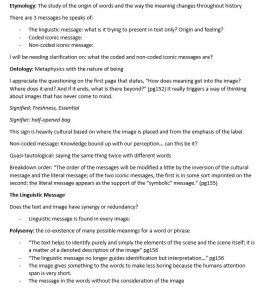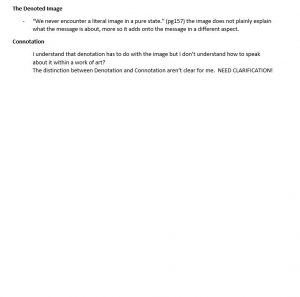Etymology – etymology means the study of root of linguistic change, especially as manifested in individual words.
Polysemy – the ability of a word to posses several meaning.
linguistic sign – a sign is a combination between a concept and a sound image.
Connoted – imply or suggest.
Denoted – indication
Decipher – Convert into normal language.
Assonance – the repetition of the sound of a vowel.
Anchorage- frequent function of the linguistic message and commonly found in press photography and advertisements.
mythical idea of Life. it means that the linguistic nature image is being presented again and finally it takes action
There are 3 messages.
The linguistic Message, Denoted Image and Rhetoric of the Image.
1st message is produce by the image and linguistic is the medium and captions, labels and marginals supports the linguistic.
The linguistic message is a sign or indication and suggested or the concept.
The reading discuss about the sign stages that the first sign of the image is idea and how it represented the product. Second sign talks about the it is more or less equal to noticeable to bring together the signifier for the product. As they explore the image, they discover the two other sign. 1 is a collection of different object that transmit the idea that is different service. In other sign, it is about the composition of the image that is an illustration that express in other language is “still life”.
As reading goes on the photograph analyzed that the messages 1 is linguistic message, 2 is coded iconic message and a non-coded iconic message.
Denoted Image is that image is speaking the distinction between the literal message and the symbolic message and it is operational.
Rhetoric of the image is where the sign of the 3rd message were message cultural that on and off when the signifier become enlarge over the whole image however a sign is separated from the others than the composition that carries a set of principals of signified.





